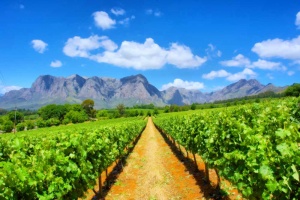South Africa's Top 10 most planted vines between 2011 and 2015

The face of South African winemaking is changing every year as more growers understand the best regions and soils where to plant and grow different types of vines and grape varieties.
The Drinks Business has looked at figures from SAWIS to set out the 10 fastest planted vine types in South Africa between 2011 and 2015. A time when 15 new varieties were introduced to the country for the first time.
1 Pinotage
2011: 6,535.26 ha
2015: 7,364.33 ha
Number of hectares added: 829.07
% change: 12.7%
The variety gained 829.07 hectares in plantings between 2011 and 2015, making it the country’s current fastest-growing grape variety, way ahead of Ruby Cabernet which added just 213 hectares.
2 Ruby Cabernet
2011: 2,192.72 ha
2015: 2,406.01 ha
Number of hectares added: 213.29
% change: 9.7%
3 Muscat de Fruntignan
2011: 676.07 ha
2015: 821.48 ha
Number of hectares: 145.41
% change: 21.5%
Part of the Muscat family, the grape gets its name from its small berries that grow tightly clustered. Compared with European strains, South African Muskadel tends to show darker, pinker-hued skins, with red and white varieties growing mainly in the the Breede River region.
In South Africa, it is almost exclusively used in dessert wines, including the famous dessert wines of Constantia, producing intense, raisin-like aromas.
4 Grenache
2011: 207.72 ha
2015: 322.24 ha
Number of hectares added: 114.52
% change: 55.1%
In South Africa, there is growing interest in Grenache, which is increasingly being used to produce single varietal wines, as well as blends.
5 Pinot Noir
2011: 1,019.43 ha
2015: 1,119.64 ha
Number of hectares added: 100.21
% change: 9.8%
Pinot Noir is gaining traction in the cooler coastal regions of South Africa like Hemel-en-Aarde, on the Hermanus wine route.
6 Petit Verdot:
2011: 674.55 ha
2015: 764.02 ha
Number of hectares added: 89.47
% change: 13.3%
While it is still used predominantly in blends in South Africa, winemakers are increasingly experimenting with the variety as a single varietal.
7 Roobernet
2011: 137.43 ha
2015: 222.05 ha
Number of hectares added: 84.62
% change: 61.6%
Indigenous to South Africa, Roobernet is a cross between Pontac and Cabernet Sauvignon. The variety was engineered to thrive in a warmer climate without the need for much irrigation. It’s commonly used in red blends in South Africa, often with Pinotage – a blend unique to the country.
8 Villard Blanc
2011: 234.82 ha
2015: 319.20 ha
Number of hectares added: 84.38
% change: 35.9%
Villard Blanc is described as a “light-skinned French hybrid in decline, but still widely scattered around the globe” in Jancis Robinson’s Wine Grapes. A crossing of Seibel 6468 with Subéreux, throughout the 1960s it was one of the most planted varieties in France, but plantings have dramatically declined since then. The high-yielding grape offers similar characteristics to Sauvignon Blanc, but with less concentration and aromatics.
9 Ugni Blanc Trebbiano
2011: 80.34 ha
2015: 157.15 ha
Number of hectares added: 76.81
% change: 95.6%
Also known as Trebbiano, an additional 76 hectares of Ugni Blanc has been planted since 2011. In South Africa it’s typically used in the production of brandy and in bulk white blends.
10 Pinot Gris
2011: 276.40 ha
2015: 345.85 ha
Number of hectares added: 69.45
% change: 25.1%
Pinot Gris is an aromatic white grape mutated from Pinot Noir, first originating in Burgundy but also in the Rheinland-Pfalz and Baden in south west Germany. In South Africa, Pinot Gris tends to be lighter bodied compared with Italian Pinot Grigio, with subtropical, stone fruit flavours and some spicy notes.
